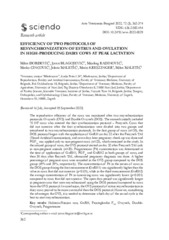Prikaz osnovnih podataka o dokumentu
Efficiency of two protocols of resynchronization of estrus and ovulation in high-producing dairy cows at peak lactation
| dc.creator | Đorđević, Milan | |
| dc.creator | Blagojević, Jovan | |
| dc.creator | Radinović, Miodrag | |
| dc.creator | Cincović, Marko | |
| dc.creator | Maletić, Jelena | |
| dc.creator | Kreszinger, Mario | |
| dc.creator | Maletić, Milan | |
| dc.date.accessioned | 2023-03-31T08:18:18Z | |
| dc.date.available | 2023-03-31T08:18:18Z | |
| dc.date.issued | 2022 | |
| dc.identifier.issn | 0567-8315 | |
| dc.identifier.uri | https://vet-erinar.vet.bg.ac.rs/handle/123456789/2832 | |
| dc.description.abstract | The reproductive efficiency of the cows was monitored after two resynchronization protocols: Ovsynch (OVS) and Double Ovsynch (DOS). The research initially included 70 HF cows who entered the first synchronization protocol - Presynch. Cows that did not conceive after the first synchronization were divided into two groups and introduced to two resynchronization protocols. In the first group of cows (n=35), the DOS protocol began with the application of GnRH on day 22 after the Presynch TAI (Timed Artificial Insemination), and seven days later pregnancy check-up was done and PGF2α was applied only to non-pregnant cows (n=23), which remained in the study. In the second group of cows, the OVS protocol started on day 32 after Presynch TAI only in non-pregnant animals (n=20). Progesterone (P4) concentration was determined at the time of application of GnRH1, PGF2α and GnRH2 in both groups of cows, and then 30 days after Resynch TAI, ultrasound pregnancy diagnosis was done. A higher percentage of pregnant cows were recorded in the OVS group compared to the DOS group (45% and 35%, respectively). The concentration of P4 in the serum of cows in the DOS group during the first measurement (GnRH1) was significantly higher than the value in cows that did not conceive (p<0.05), while in the third measurement (GnRH2) the average concentration of P4 in conceiving cows was significantly lower (p<0.001) compared to cows that did not coincive. The open days period was significantly longer in pregnant cows that were resynchronized using the DOS protocol compared to cows from the OVS protocol. In conclusion, the OVS protocol of estrus resynchronization in dairy cows proved to be more successful than the DOS protocol. However, considering the advantages the OVS, it is needed to determine which day of the sexual cycle is the best to start resynchronization. | sr |
| dc.publisher | Sciendo | sr |
| dc.relation | info:eu-repo/grantAgreement/MESTD/inst-2020/200143/RS// | sr |
| dc.rights | openAccess | sr |
| dc.rights.uri | https://creativecommons.org/licenses/by/4.0/ | |
| dc.source | Acta Veterinaria | sr |
| dc.subject | Holstein-Friesian cow | sr |
| dc.subject | GnRH | sr |
| dc.subject | Prostaglandin F2α | sr |
| dc.subject | Ovsynch | sr |
| dc.subject | Double-Ovsynch | sr |
| dc.subject | Progesterone | sr |
| dc.title | Efficiency of two protocols of resynchronization of estrus and ovulation in high-producing dairy cows at peak lactation | sr |
| dc.type | article | sr |
| dc.rights.license | BY | sr |
| dc.citation.volume | 72 | |
| dc.citation.volume | 3 | |
| dc.citation.spage | 362 | |
| dc.citation.spage | 374 | |
| dc.identifier.doi | 10.2478/acve-2022-0029 | |
| dc.identifier.fulltext | http://veterinar.vet.bg.ac.rs/bitstream/id/8312/bitstream_8312.pdf | |
| dc.type.version | publishedVersion | sr |

